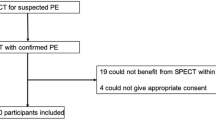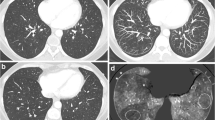Abstract.
Our objective was to evaluate, in a routine clinical setting, the role of spiral CT as a second procedure in patients with clinically suspected pulmonary embolism (PE) and abnormal perfusion scan. We prospectively studied the role of spiral CT in 279 patients suspected of PE. All patients started their diagnostic algorithm with chest radiographs and perfusion scintigraphy. Depending on the results of perfusion scintigraphy, patients proceeded to subsequent levels in the algorithm: stop if perfusion scintigraphy was normal; CT and pulmonary angiography if subsegmental perfusion defects were seen; ventilation scintigraphy followed by CT when segmental perfusion defects were seen; and pulmonary angiography in this last group when results of ventilation/perfusion scintigraphy and CT were incongruent. Reference diagnosis was based on normal perfusion scintigraphy, high probability perfusion/ventilation scintigraphy in combination with abnormal CT, or pulmonary angiography. If PE was present, the largest involved branch was noted on pulmonary angiography, or on spiral CT scan in case of a high-probability ventilation/perfusion scan and a positive CT scan. A distinction was made between embolism in a segmental branch or larger, or subsegmental embolism. Two hundred seventy-nine patients had abnormal scintigraphy. In 27 patients spiral CT and/or pulmonary angiography were non-diagnostic and these were excluded for image analysis. Using spiral CT we correctly identified 117 of 135 patients with PE, and 106 of 117 patients without PE. Sensitivity and specificity was therefore 87 and 91%, respectively. Prevalence of PE was 53%. Positive and negative predictive values were, respectively, 91 and 86%. In the high-probability group, sensitivity and specificity increased to 97 and 100%, respectively, with a prevalence of 90%. In the non-high probability-group sensitivity and specificity decreased to 61 and 89%, respectively, with a prevalence of 25%. In a routine clinical setting single-detector spiral CT technology has limited value as a second diagnostic test because of low added value in patients with a high-probability lung scan and low sensitivity in patients with non-high-probability lung scan result.

Similar content being viewed by others
References
Kauczor HU, Heussel CP, Thelen M (1999) Update on diagnostic strategies of pulmonary embolism. Eur Radiol 9:262–275
Hull RD, Hirsh J, Carter CJ, Raskob GE et al. (1985) Diagnostic value of ventilation–perfusion lung scanning in patients with suspected pulmonary embolism. Chest 88:819–828
Schibany N, Fleischman D, Thallinger C, Schibany A, Hane J, Ba-Ssalamah A, Herold CJ (2001) Equipment availability and diagnostic strategies for suspected pulmonary embolism in Austria. Eur Radiol 11:2287–2294
The PIOPED investigators (1990) Value of the ventilation/perfusion scan in acute pulmonary embolism. Results of the prospective investigation of pulmonary embolism diagnosis (PIOPED). J Am Med Assoc 263:2753–2759
Van Erkel AR, van Rossum AB, Bloem JL, Kievit J, Pattynama PMT (1996) Spiral CT angiography for suspected pulmonary embolism: a cost-effectiveness analysis. Radiology 201:29–36
Rathbun SW, Raskob GE, Whitsett TL (2000) Sensitivity and specificity of helical computed tomography in the diagnosis of pulmonary embolism: a systematic review. Ann Intern Med 132:227–232
Ferretti GR, Bosson PD, Buffaz PD et al. (1997) Acute pulmonary embolism: role of helical CT in 164 patients with intermediate probability at ventilation–perfusion scintigraphy and normal results at duplex US of the legs. Radiology 205:453–458
Mayo JR, Remy-Jardin M, Müller NL et al. (1997) Pulmonary embolism: prospective comparison of spiral-CT with ventilation–perfusion scintigraphy. Radiology 205:447–452
Remy-Jardin M, Remy J, Deschildre F et al. (1996) Diagnosis of pulmonary embolism with spiral CT: comparison with pulmonary angiography and scintigraphy. Radiology 200:699–706
Van Rossum AB, Treurniet FE, Kieft GJ, Smith SJ, Schepers-Bok R (1996) Role of spiral volumetric computed tomographic scanning in the assessment of patients with clinical suspicion of pulmonary embolism and an abnormal ventilation/perfusion lung scan. Thorax 51:23–28
Goodman LR, Curtin JJ, Mewissen MW et al. (1995) Detection of pulmonary embolism in patients with unresolved clinical and scintigraphic diagnosis: helical CT versus angiography. Am J Roentgenol 164:1369–1374
Drucker EA, Rivitz SM, Shepard JA et al. (1998) Acute pulmonary embolism: assessment of helical CT for diagnosis. Radiology 209:235–241
Worsley DF, Alavi A (1995) Comprehensive analysis of the results of the PIOPED study. J.Nucl Med 36:2380–2387
Sagel SS, Greenspan RH (1970) Nonuniform pulmonary arterial perfusion: pulmonary embolism. Radiology 99:541–548
Blum AG, Delfau F, Grignon B et al. (1994) Spiral-computed tomography versus pulmonary angiography in the diagnosis of acute massive pulmonary embolism. Am J Cardiol 74:96–98
Qanadli SD, El Hajjam M, Mesurolle B et al. (2000) Pulmonary embolism detection: prospective evaluation of dual-section helical CT versus selective pulmonary arteriography in 157 patients. Radiology 217:447–455
Schoepf UJ, Kessler MA, Rieger CT, Herzog P, Klotz E, Weisgigl S, Becker CR, Exarhos DN, Reiser MF (2001) Multislice CT imaging of pulmonary embolism. Eur Radiol 11:2278–2286
Stein PD, Goldhaber SZ, Gottschalk A et al. (1998) Opinions/hypotheses: opinions regarding the diagnosis and management of venous thromboembolic disease. Chest 113:499–504
Remy-Jardin M, Remy J, Artaud D, Deschildre F, Duhamel A (1997) Peripheral pulmonary arteries: optimization of the spiral CT acquisition protocol. Radiology 204:157–1563
Beigelman C, Chartrand-Lefebvre C, Howarth N, Grenier P (1998) Pitfalls in diagnosis of pulmonary embolism with helical CT angiography. Am J Roentgenol 171:579–585
Miniati M, Pistolesi M, Marini C, Ricco G di, Formichi B, Prediletto R et al. (1996) Value of perfusion lung scan in the diagnosis of pulmonary embolism: results of the Prospective Investigative Study of Acute Pulmonary Embolism diagnosis (PISA-PED). Am J Respir Crit Care Med 154:1387–1393
Garg K, Welsh CH, Feyerabend AJ et al. (1998) Pulmonary embolism: diagnosis with spiral CT and ventilation–perfusion scintigraphy: correlation with pulmonary angiographic results or clinical outcome. Radiology 208:201–208
Van Beek EJ, Bakker AJ, Reekers JA (1996) Pulmonary embolism: interobserver agreement in the interpretation of conventional angiographic and DSA images in patients with nondiagnostic lung scan results. Radiology 198:721–724
Acknowledgements.
Financial support for this study was provided by the Dutch National Health Insurance Council (Ziekenfondsraad), grant nr. D94–090. The results of this study are part of the results of the ANTELOPE study group (Advances of New Technologies Evaluating Localisation Of Pulmonary Embolism), a Dutch prospective multicenter trial on pulmonary embolism. Participants: Academic Medical Center, Amsterdam, Dept. of Vascular Medicine, Dept. of Nuclear Medicine, Dept. of Radiology: B.J. Sanson, H.R. Büller, H.J. Baarslag, and J.A. Reekers. Leiden University Medical Center, Leiden. Dept. of Radiology, Dept. of General Internal Medicine, Dept. of Nuclear Medicine: W. de Monyé, P.M.T. Pattynama, M.V. Huisman, and A.E. Meinders. Leyenburg Hospital, The Hague: Dept. of Radiology, Dept. of General Internal Medicine: M.J.L. van Strijen, G.J. Kieft, F.E.E. Treurniet, and S.J. Smith. Slotervaart Hospital, Amsterdam. Dept. of Internal Medicine: M.R. MacGillavry, D.P.M. Brandjes, and F. Turkstra. University Hospital VU, Amsterdam: Dept. of Pulmonary Medicine, Dept. of Nuclear Medicine, Dept. of Radiology: P.J. Hagen, P.E. Postmus, F.G. van den Berg, R.P. Golding, and R.A. Manoliu. University Hospital Utrecht, Utrecht: Dept. of Radiology, Dept. of General Internal Medicine, Dept. of Pulmonary Medicine: I.J.C. Hartmann, J.D. Banga, T.H. Lo, and P.F.G.M. van Waes. The authors thank A. van de Berg for her help with statistical analysis of the results.
Author information
Authors and Affiliations
Corresponding author
Rights and permissions
About this article
Cite this article
van Strijen, M.J.L., de Monyé, W., Kieft, G.J. et al. Diagnosis of pulmonary embolism with spiral CT as a second procedure following scintigraphy. Eur Radiol 13, 1501–1507 (2003). https://doi.org/10.1007/s00330-002-1709-3
Received:
Revised:
Accepted:
Published:
Issue Date:
DOI: https://doi.org/10.1007/s00330-002-1709-3




